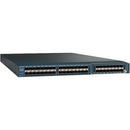Description
Cisco Fabric Interconnect
Discover the backbone of Cisco UCS ecosystems with Cisco Fabric Interconnect, a purpose-built appliance that unifies server connectivity, storage traffic, and policy-driven networking into a single, scalable fabric. Built for data centers that demand reliability, performance, and simplified operations, this interconnect delivers a streamlined path from provisioning to production. Whether you’re running a dense virtualized environment, a large-scale blade enclosure, or an edge deployment, Cisco Fabric Interconnect provides a cohesive platform to optimize traffic flow, accelerate workloads, and reduce complexity across your IT infrastructure.
- Unified fabric architecture that consolidates server, storage, and network traffic for streamlined cabling and predictable performance.
- Centralized management through Cisco UCS Manager, enabling policy-based provisioning, automated firmware coordination, and real-time telemetry across the fabric.
- High availability by design, featuring redundant pathways and components that minimize downtime during maintenance or failover events.
- Scalable performance to support dense server footprints and growing workloads, ensuring your data center can evolve without disruption.
- Compact, rack-ready form factor with efficient power usage, ideal for data centers, labs, and distributed edge deployments.
Technical Details of Cisco Fabric Interconnect
- Dimensions: 17.3 in (W) x 30 in (D) x 1.7 in (H).
- Form factor: 1U rack-mountable chassis (approximately 1.7 inches tall).
- Management: Centralized control via Cisco UCS Manager for policy-based automation and unified fabric oversight.
- Fabric architecture: Unified data/fabric interconnect that links servers, networking, and storage resources into a cohesive fabric.
- Connectivity: High-throughput uplinks and scalable data plane to support demanding workloads with low latency.
- Power and reliability: Model-dependent power options with potential redundancy; refer to the official datasheet for exact specifications and hot-swappable capabilities.
How to Install Cisco Fabric Interconnect
- Plan your installation by assessing your rack space, cooling, and cable management to ensure easy access and future growth.
- Mount the Fabric Interconnect in a standard 19-inch rack, secure it with rails, and connect the required power supplies according to the installation guide.
- Connect high-speed uplinks to your data center network and storage interconnects following Cisco’s recommended topology for your UCS deployment.
- Power on the device and perform the initial configuration using Cisco UCS Manager or the built-in setup wizard, including management IP, administrator credentials, and basic policies.
- Provision servers and storage resources through UCS profiles, apply fabric policies, and validate connectivity with basic throughput tests and telemetry checks.
Frequently asked questions
- What is Cisco Fabric Interconnect used for? It serves as the centralized fabric for Cisco UCS environments, integrating servers, storage, and networking into a single, manageable platform.
- How does it improve data center efficiency? By consolidating multiple functions into one device, it reduces cabling, simplifies management, accelerates provisioning, and enables consistent policy enforcement across the fabric.
- Is the Fabric Interconnect scalable? Yes. It is designed to scale with growing workloads and expanding server footprints, providing a foundation for a dynamic and future-ready data center.
- What kind of management is available? Centralized management is provided through Cisco UCS Manager, offering policy-based automation, firmware coordination, and real-time visibility into the fabric.
- What should I check before purchasing? Verify model-specific specifications, including dimensions, power options, redundancy, and supported UCS configurations, to ensure compatibility with your servers and storage.
Customer reviews
Showing - Of Reviews






